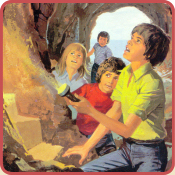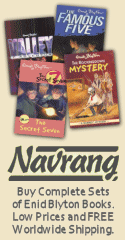
The Buttercup Farm Family

Book Details...
First edition: 1951
Publisher: Lutterworth Press
Illustrator: Ruth Gervis
Category: Caravan Family
Genre: Family
Type: Novels/Novelettes
Publisher: Lutterworth Press
Illustrator: Ruth Gervis
Category: Caravan Family
Genre: Family
Type: Novels/Novelettes
On This Page...
Reprints
1. 1981 Sparrow, illustrations and cover by Joyce Smith and David Dowland
2. 1989 Beaver, illustrations by Joyce Smith and David Dowland, cover uncredited
3. 1997 Mammoth, illustrations by Ruth Gervis, cover by Richard Jones
4. 2017 Egmont, illustrations and cover by Aleksei Bitskoff
2. 1989 Beaver, illustrations by Joyce Smith and David Dowland, cover uncredited
3. 1997 Mammoth, illustrations by Ruth Gervis, cover by Richard Jones
4. 2017 Egmont, illustrations and cover by Aleksei Bitskoff

Wraparound dustwrapper from the 1st edition, May 1951 @ 4/6, illustrated by Ruth Gervis

Frontis from the 1st edition, illustrated by Ruth Gervis
As mentioned earlier in my article, it is interesting to note how the children of this series grow and develop with each passing book. This happened with the swimming episodes depicted in The Caravan Family, when they couldn't swim, through The Saucy Jane Familywhen they were taught, to The Seaside Family where they were all proficient swimmers. The same can be said for other details in their characteristics. Like in the short story 'A Caravan Adventure' (Enid Blyton's Treasury) our children are scared of cows in the first book of this series, being terrified when they brush up against the caravan at night or come too close to the camp during the day. By the time they are holidaying at Buttercup farm, the children are actually helping to milk the cows, getting calves used to suckling and feeding pigs, hens etc as if they have been on a farm all their lives. This 'passage of time' element is one of the most interesting aspects about the Caravan Family series, for not only do the children grow throughout, but machinery and everyday life can also been seen to be changing. Try comparing The Caravan Family with The Buttercup Farm Family and you will see some quite marked differences in the depiction of farm life circa 1945 and the same farm revisited now in 1948-49 (according to the narrative, actually only a year later). This is most apparent (and also confusing) in the final 'harvest time' sections of each book, where horses are (apparently) still being used to pull the machinery in The Caravan Family, along with hand implements to cut and turn the hay. Three (or one) years later, and the corn is being harvested in The Buttercup Farm Family by what Enid calls a 'self-binder' or 'reaper-binder'. The reason I say this becomes confusing is the fact that, according to Ann, until 'farm', the children had not witnessed one of these machines in action, despite mention of it by Enid in the closing chapters of the first book. In The Buttercup Farm Family they watch the self-binder at work and describe it as being 'like magic', even though they witnessed it only the summer before...a rare example of Enid having a memory slip so early in her career? Or did she merely think that no one would notice such a tiny detail in books written three years and dozens of magazine issues later?(p>
Despite many strengths, including many very interesting farm details of hatching chickens and ducks, newly-born baby lambs and wish-fulfilment by the bucket-load, we come to realise that much of what happens in The Buttercup Farm Family is quite simple a regurgitation of the occurrences in a dozen or so of Enid's other farm-based tales. Even the beginning of the novel, in which Mummy and Daddy decide to go off to America leaving their children behind, comes across as another of those aggravatingly convenient moments we have met with so many times before in the 'Five' and 'Secret' books. The easy-going acceptability of the children in this instance is quite unbelievable; spoiling the beginning of what otherwise is a very entertaining and fairly realistic read. The opening chapter, indeed, is the one moment in the entire series where what happens seems terribly contrived. Why would the children accept so readily the fact that their parents want to leave them at Uncle Ned's farm for six months whilst they themselves go to America? Nowadays especially there would be a right hullabaloo if parents were to suggest leaving their offspring behind for six months whilst they go off to America. These children merely smile and see their parents viewpoint almost at once, however, with Mike actually saying 'you go, Mummy. We won't be selfish and make a fuss. You deserve a holiday, doesn't she Daddy?'!!
Later on in the book, Enid also makes good use of some familiar occurrences with which to pad-out the story, not least an episode about ducklings having been reared by a hen, suddenly taking to the duck pond, much to the consternation of their 'step mother' — something Enid used in short stories and in a chapter of her longer novel 'Shadow the Sheepdog'. The descriptions of the sheep dogs at work in chapter six also echo the passages in 'Shadow' where we see the dogs taking the sheep to a hill across the valley, crossing a narrow bridge on the way.
Like the other stories in this series, Enid paints her canvass with only a few descriptive brush marks, but manages to conjure up some lovely images of bygone summer days. For example, at the start of the last chapter of The Buttercup Farm Family — 'The summer went by. It was sunny and warm and full of colour. The may spread along the hedges like snow. It faded, and buttercups came to fill the fields with gold.' There are passages like this throughout the series, but Buttercup Farm seems to use them to best effect. As in The Caravan Family, Enid returns to the beauty of the cut corn standing in the fields, giving us almost the same description as in the first book: '...the fields looked very lovely and peaceful. Each shock had its own shadow, and as the sun went down, the shadows grew longer and longer.'
One of the most disappointing aspects of this addition to the series, when compared to the others is the fact that the main child characters do not actually seem to 'grow' very much during the course of the story. As mentioned earlier, from book to book they expand in both knowledge and character, from being afraid of cows to milking them, from being unable to swim to being adept at it, but during 'farm' the children do not seem to grow very much at all, not even in a moralistic or spiritual sense as they did in 'seaside'. At the end of 'farm' there have really been no lessons to learn, unless we count the general looking after of animals and the experiences of everyday farm life which the children have been witness to. The children have acquired the skills to look after a puppy, a lamb, twin calves and 'heaps of piglets', but as to whether these are actual life-changing experiences is doubtful to say the least. The most they have learned this time seems to be how to get on with and look after animals — and this was something they had learned in 'caravan' all those books before.
Once again, this book benefits greatly from Ruth Gervis's excellent illustrations. Gervis had, by this time, become Enid's regular choice of illustrator for the series when published in book form (though Playwayscontinued to use other more 'realistic' artists). Her sweeping lines, particularly in the depictions of the harvest at the books close, seem perfectly suited to the pictures of sheaves and stooks as the children gather them in. Her illustrations once again help to give this book as well as the series an overall feel and look which is perfectly suited to the simple prose Enid herself supplies.
Enid brings the story to a satisfying closure with the harvest home episode helping to bring the tale to a natural stopping point. The children bring the harvest home to find that their parents have arrived home too, just in time for the end of chapter twelve. This mirrors the end of the first book in the series, where Mummy and Daddy arrive back just in time to announce they have found schools for the children. In this story, though it seems fitting to end it with a family reunion, one also feels that Enid had no idea how to bring the book to a close and so merely brings the parents back on the last page to tie up all the loose ends quickly and conveniently within the word limit Playways had imposed. It is perhaps the least satisfying conclusion to the least satisfying book in the series, but is more than made up for with the book that follows — the 'real life' adventures on board the Queen Elizabeth. These illustrations are hidden by default to ensure faster browsing. Loading the illustrations is recommended for high-speed internet users only.








